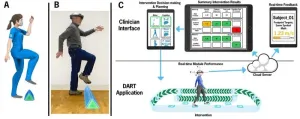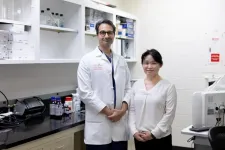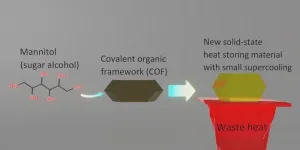Power meals: Child care-provided meals are associated with improved child and family health
2023-09-18
Philadelphia, September 18, 2023 – Very young children who attend child care and receive onsite meals and snacks were more likely to be food secure and in good health, and less likely to be admitted after a hospital emergency department visit than children in child care whose meals and snacks were provided from home, according to a new study in the Journal of the Academy of Nutrition and Dietetics, published by Elsevier. These potential benefits could extend beyond the children themselves to their families, including through possible reductions in stress, and to society as a whole through potentially significant healthcare cost savings.
Lead author Stephanie ...
DOE backs Rice study of how soils store carbon
2023-09-18
HOUSTON – (Sept. 18, 2023) – Two Rice University scientists have received a 3-year grant from the Department of Energy (DOE) to investigate a form of carbon storage that is as little understood as it is ubiquitous: soil.
Mark Torres, an assistant professor of Earth, environmental and planetary sciences, and Evan Ramos, a postdoctoral fellow in the Torres lab, will track how key minerals form in a watershed to build a fuller picture of the processes that allow soil to store carbon as organic matter.
“Soil on Earth contains three times more carbon than the atmosphere,” Ramos said. “We ...
University of Colorado Anschutz Medical Campus receives $54 million from NIH
2023-09-18
The National Institutes of Health has awarded $54 million over a seven-year period to the CCTSI at CU Anschutz. The grant from the National Center for Advancing Translational Sciences (NCATS) will fuel biomedical research and training across the state. This is the fourth consecutive time the NIH has funded the CCTSI since 2008 through its Clinical Translational Science Award (CTSA) program.
“This powerful grant will allow the University of Colorado to conduct leading-edge research that can directly impact health and patient care, reduce health disparities across our state and remain poised to respond to public ...
UNIST and Pusan National University Yangsan Hospital collaborate on advanced 3D printing medical device technology
2023-09-18
UNIST, in collaboration with Pusan National University Yangsan Hospital, has embarked on an exciting joint venture to research and develop advanced 3D printing medical device technology.
The UNIST 3D Printing Convergence Technology Center recently signed a business agreement with the Medical Device Usability Test Center at Pusan National University Yangsan Hospital. This agreement outlines their collaborative efforts in various areas, including the research and development of 3D printing-based medical devices as well as support for the commercialization of domestically developed devices.
Notably, Yangsan Pusan National University ...
The missing link to make easy protein sequencing possible?
2023-09-18
There has been a real race among scientists to create a technology that enables easy protein sequencing. Professor of Chemical Biology Giovanni Maglia of the University of Groningen has now found the missing piece in the puzzle: a way to transport a protein through a nanopore, which allows sequencing of proteins in a simple, handheld device.
DNA sequencing has been a revolution in how we understand life, and sequencing proteins is the next holy grail. Maglia explains: ‘DNA is mostly static. The processes in our cells are executed by proteins: they do the actual work. ...
Ochsner Health to integrate generative AI into patient messaging
2023-09-18
This month, Ochsner Health is launching a pilot program that uses AI to draft simple messages to patients in the MyOchsner app portal. A small group of Ochsner clinicians will participate in testing a new Epic feature that drafts responses to routine patient requests, which will then be reviewed and edited by the clinicians. The feature is meant to speed up app response time to patients and allows doctors to spend more time with patients.
“Ochsner has long been a leader in using digital tools to improve the patient experience,” said Ochsner ...
Using augmented reality to make Parkinson's disease physical therapy more accessible
2023-09-18
An augmented-reality headset is an effective digital tool for improving posture and gait in people with Parkinson’s disease, according to a recent Cleveland Clinic trial. Findings were published in Neurorehabilitation and Neural Repair.
Augmented reality, or AR, allows users to complete digital programs projected into the world around them. The “Dual-task augmented Reality Treatment” (DART) uses the Microsoft HoloLens2 to run patients through dual-task training (DTT), a series of tasks designed to engage the brain and body simultaneously.
Activities ...
State grant allows for UC’s continued research on firefighter protective gear
2023-09-18
A team of UC researchers across three colleges has been awarded an additional $1.5 million state grant to continue research on improving firefighter protective gear.
In 2022, the Ohio Bureau of Workers’ Compensation (BWC) awarded a UC team an initial $1.2 million to provide proof of concept on the development of a firefighter jacket liner that brings a firefighter’s body temperature down through advanced cooling technology and protects the body from other external hazards.
That grant, and the new $1.5 million grant to carry the proof of concept to commercialization, ...
Pediatric ED visits, hospitalizations for self-harm up during pandemic, especially in adolescent females; "Less is better" is the best message when talking to patients about alcohol
2023-09-18
CMAJ headlines:
Pediatric ED visits and hospitalizations for self-harm, suicidal thoughts increased in Canada during pandemic, especially in young adolescent females
"Less is better" is the best message when talking to patients about alcohol
Pediatric ED visits and hospitalizations for self-harm, suicidal thoughts increased in Canada during pandemic, especially in young adolescent females
The COVID-19 pandemic had an outsized impact on the mental health of adolescents, especially young adolescent females, with a higher-than-expected number of emergency department (ED) visits and hospitalizations for self-harm and suicidal ideation, according to two new research ...
Study explores how healthcare workers share appreciation, promote positive workplace culture
2023-09-18
Healthcare organizations, in reviewing care delivery opportunities and providing feedback to staff, often focus on what went wrong, but a new study suggests that reversing this perspective may help organizations improve their work culture by understanding what went right. A team of Mass General Brigham researchers analyzed peer-to-peer positive feedback, systematically collected when caring for a dying patient as part of a mandatory mortality review process. They found that standardized collection and sharing of positive feedback — what went right — is a feasible way to increase mutual ...
Researchers create “lipidomic map,” offering insights into immunology
2023-09-18
An international team of scientists has developed a method for simultaneously detecting thousands of lipid molecules that are displayed to T cells in the human immune system. The study, co-led by D. Branch Moody, MD, of the Division of Rheumatology, Immunity and Inflammation at Brigham and Women's Hospital, a founding member of the Mass General Brigham healthcare system, represents a collaboration among researchers from Oxford, United Kingdom, Melbourne, Australia and Groningen, Netherlands. Results are published in Cell.
The team developed a new and sensitive method to detect more than 2,000 lipids bound to CD1 ...
UTHealth Houston study: Artificial intelligence software improves endovascular thrombectomy treatment times for stroke patients
2023-09-18
The implementation of artificial intelligence-powered large vessel occlusion (LVO) detection software for acute stroke triage can improve endovascular thrombectomy treatment times, according to new research from UTHealth Houston.
The study, which was published today in JAMA Neurology, was led by co-first authors Youngran Kim, PhD, assistant professor of management, policy, and community health with UTHealth Houston School of Public Health; and Juan Carlos Martinez-Gutierrez, MD, a former surgery fellow in the Vivian L. Smith Department of Neurosurgery with McGovern Medical School at UTHealth ...
Economic burden of US youth violence injuries
2023-09-18
About The Study: This economic evaluation’s findings indicate that the economic burden of youth violence, including medical care, lost productivity, reduced quality of life from injury morbidity, and avoidable mortality, reached $122 billion in 2020, dominated by male firearm homicides. Prevention strategies can reduce this substantial burden.
Authors: Cora Peterson, Ph.D., of the Centers for Disease Control and Prevention in Atlanta, is the corresponding author.
To access the embargoed study: Visit our For The Media website at this link https://media.jamanetwork.com/
(doi:10.1001/jamapediatrics.2023.3235)
Editor’s ...
Screen time and developmental performance among children at 1-3 years of age
2023-09-18
About The Study: Increased TV/DVD screen time from age 1 year negatively affected later development in this study of 57,980 children. To reduce the negative consequences of excessive media use, researchers and health care professionals should encourage family media management and recommend social support for parents who tend to rely on the media.
Authors: Midori Yamamoto, Ph.D., of Chiba University in Chiba, Japan, is the corresponding author.
To access the embargoed study: Visit our For The Media website at this link https://media.jamanetwork.com/
(doi:10.1001/jamapediatrics.2023.3643)
Editor’s ...
School-based health centers, access to care, and income-based disparities
2023-09-18
About The Study: In this study using nationally representative survey data with difference-in-differences analysis of school-based health center (SBHC) adoption, SBHCs were associated with access to care and reduced income-based disparities. These findings support additional SBHC expansion.
Authors: Michel Boudreaux, Ph.D., of the University of Maryland in College Park, is the corresponding author.
To access the embargoed study: Visit our For The Media website at this link https://media.jamanetwork.com/
(doi:10.1001/jamanetworkopen.2023.34532)
Editor’s ...
Buprenorphine dose and time to discontinuation among patients with opioid use disorder in the era of fentanyl
2023-09-18
About The Study: The results of this study of 6,499 patients initiating buprenorphine treatment between 2016 and 2020 suggest that the value of higher buprenorphine doses than currently recommended needs to be considered for improving retention in treatment.
Authors: Laura C. Chambers, Ph.D., M.P.H., of Brown University in Providence, Rhode Island, is the corresponding author.
To access the embargoed study: Visit our For The Media website at this link https://media.jamanetwork.com/
(doi:10.1001/jamanetworkopen.2023.34540)
Editor’s Note: Please see the article for additional information, including other authors, ...
Telecare cuts costs, boosts quality of life for dementia patients
2023-09-18
A UCSF telecare program that improves outcomes for patients with dementia and lightens the load for unpaid caregivers also has the surprising bonus of cutting Medicare costs, according to UC San Francisco research.
In the study, publishing in JAMA Internal Medicine on Sept. 18, 2023, researchers, led by UCSF, compared the Medicare costs of 780 patients with dementia. The patients were randomized 2:1 to receive Care Ecosystem support – which included medical and practical assistance – or their usual care for a 12-month period. Both groups were similar in age, severity of dementia ...
Higher buprenorphine doses associated with improved retention in treatment for opioid use disorder
2023-09-18
Individuals with opioid use disorder who were prescribed a lower buprenorphine dose were 20% more likely to discontinue treatment than those on a higher dose, according to a study of patients prescribed buprenorphine in Rhode Island from 2016 to 2020, as fentanyl became widely available. The study, published today in JAMA Network Open, was supported by the National Institute on Drug Abuse (NIDA), part of the National Institutes of Health, and conducted by researchers at Brown University, Providence, Rhode Island; NIDA and the Rhode Island ...
Tracking down the formation of cardenolides in plants
2023-09-18
Plants produce an impressive array of metabolites, including many medically valuable steroids. Well-known examples of this class of substances obtained from plants are cardenolides. As early as 1785, the British physician William Withering (1741-1799) published a book on the red foxglove and its use in medicine (An account of the foxglove, and some of its medical uses: with practical remarks on dropsy, and other diseases. Birmingham 1785). He had found out in experiments that taking extracts ...
The surprising origin of a deadly hospital infection
2023-09-18
Hospital staff spend a significant amount of time working to protect patients from acquiring infections while they are being cared for in the hospital. They employ various methods from hand hygiene to isolation rooms to rigorous environmental sanitation. Despite these efforts, hospital-onset infections still occur—the most common of which is caused by the bacterium Clostridioides difficile, or C. diff, the culprit of almost half a million infections in the U.S. each year.
Surprising findings from a new study in Nature Medicine suggest that the burden of C. diff infection may be less a matter of hospital transmission and more a result of characteristics associated ...
Mature sperm lack intact mitochondrial DNA, study finds
2023-09-18
New research provides insight about the bedrock scientific principle that mitochondrial DNA — the distinct genetic code embedded in the organelle that serves as the powerplant of every cell in the body — is exclusively passed down by the mother.
The study, a collaboration among Oregon Health & Science University and other institutions, published today in the journal Nature Genetics.
Scientists have long recognized the fact that mitochondrial DNA, or mtDNA, comes exclusively from egg cells in humans, meaning only the mother contributes the genetic code carried by ...
Research identifies new potential hurdle for nano-based therapies
2023-09-18
HOUSTON ― Researchers at The University of Texas MD Anderson Cancer Center have discovered that certain nano-based cancer therapies may be less effective in younger patients, highlighting the need for further investigation into the impact of aging on the body’s ability to respond to treatment.
The researchers found age-related differences are due to how effectively the liver filters the bloodstream. Younger livers are more efficient at this process, which helps limit toxins in the blood but also filters out beneficial treatments, potentially rendering them ineffective.
The study, published today in ...
Improving the properties of sweeteners for enhanced thermal energy storage
2023-09-18
As we seek more efficient utilization of waste thermal energy, use of “phase change materials (PCMs)” is a good option. PCMs have a large latent heat capacity and the ability to store-and-release heat as they change from one state of matter to another. Among many PCMs, sugar alcohols (SAs), a class of organic compounds commonly used as sweeteners, stand out due to their low cost, non-toxic, non-corrosive, and biodegradable nature. In particular, SAs generally have their melting point in 100–200 °C, which is an important temperature range where a huge amount of waste heat exists but is currently ...
Ohio State leads new global climate center on AI for biodiversity change
2023-09-18
COLUMBUS, Ohio – The Ohio State University will lead a new multimillion dollar international center devoted to using artificial intelligence to help understand climate impacts on biodiversity.
The AI and Biodiversity Change (ABC) Global Climate Center will bring together ecologists and computer scientists from six universities in the United States and Canada, with partners in UK, Europe, and Australia, to develop new AI-enabled, data-supported approaches to study how changes in climate are impacting life – including animals, plants and insects – on Earth.
$5 ...
Ohio State researchers publish national guidelines for ALS genetic testing, counseling
2023-09-18
COLUMBUS, Ohio – Researchers at The Ohio State University Wexner Medical Center and College of Medicine led the creation of evidence-based consensus guidelines for genetic testing and counseling for patients with amyotrophic lateral sclerosis (ALS), a neurodegenerative disease that affects the cells in the brain and spine.
These evidence-based, consensus guidelines provide clinicians with a framework for the offer of genetic testing and outline the information that should be provided to persons with ALS before and after testing. In addition, the guidelines provide specific recommendations regarding ...
[1] ... [1556]
[1557]
[1558]
[1559]
[1560]
[1561]
[1562]
[1563]
1564
[1565]
[1566]
[1567]
[1568]
[1569]
[1570]
[1571]
[1572]
... [8709]
Press-News.org - Free Press Release Distribution service.








